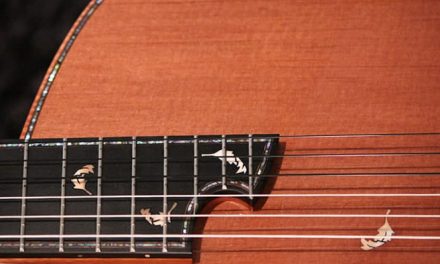Flawless fretwork is a vital component of a great playing guitar, and in this article we’re going to focus on an essential part of the fretwork process,
Fret Crowning.
For this work, most luthiers prefer to use a fret crowing file, and I’ve written extensively about how to choose the perfect file here.
But that’s not the only thing you’ll need to do the best possible job.
While having a great fret crowning file is helpful, there’s an even more critical element you need to get quality results in your fret crowning work…
You need to learn How To Use A Fret Crowning File
Why is this technique so important?
With the proper technique, you can overcome less than adequate tools, but if your technique is lacking, you can use the best file in the world still and end up with frets that:
- Don’t look good
- Take longer to file
- Result in fret buzz
- Don’t feel comfortable
- Have intonation problems
But today, I’m excited to share the simple techniques I use to get flawless fret crowning on my guitars.
I even prepared a special video to share with you that I took from the Luthier’s EDGE course, Fretwork Mastery Part II.
In it the video, I’ll demonstrate and clearly explain, the subtle nuances of my fret crowning technique so you can easily master it and start getting better results from your fretwork right away.
First, let’s start with a few basic yet important notes to give you a little more context and frame of reference before you watch the video.
What Is Fret Crowning?
Fret crowning is the process of reshaping the fret bead after it is flattened from the fret leveling process. It sounds simple enough, but in reality, there is an art to getting it just right.
This is because the size of the flattened areas can vary significantly across the length of each fret.
To avoid fret buzz, we must maintain the level surface we created while evenly rounding the surrounding material for the best comfort and action.
That requires finesse and a good technique—which I will demonstrate in the video below.
My Favorite Fret Crowning File (& Why)
I’ve owned and used many different fret crowning files over the years, but one has stood the test of time and remains my absolute favorite.
It’s the medium-size Dual Grit Diamond File by StewMac.
Here’s a quick rundown of why it works so well for me:
- Ergonomics – I love the shape and size.
- Abrasive cutting – Cuts faster with less polishing work.
- Lifetime warranty – If it wears out, you can get a new one for free.
- Rounded cutting surface – Effortlessly creates an evenly rounded profile.
You can learn more about this file and many more in my Ultimate Guide To Fret Crowning Files. It’s a deep dive into the pros and cons of many different types of fret crowning files designed to help you find your favorite file.
And if you’re still on the fence, deciding between a traditional file and a diamond file like the one I use, check out this guide: Diamond Files vs. Traditional Files.
Preparation For Fret Crowning
Before the demonstration in the video excerpt below, there were a few necessary steps taken to prepare for the crowning process that is important to be aware of, including:
- The fingerboard was protected with masking tape (and the “lint trick”)
- The frets were leveled using my string path technique to create a compound radius.
- The flat spots resulting from the leveling process were marked with a blue Sharpie.
Okay, now you’re up to speed and should be ready to jump in and watch the video below:
A key takeaway from this video is to avoid just rubbing the file along the whole fret wire but to take a more strategic and intentional approach.
We want to remove all the blue marks from the Sharpie but nothing more, keeping the shape of the fret evenly rounded with the peak directly in the center of the fret slot.
Here are some of the key components of this technique to keep in mind:
- Don’t try to do it all at once; ease into it.
- Keep it even on both sides with a pleasing rounded shape.
- Rough in the spots that need extra filing, then refine the rest to perfection.
- Make sure the peak is directly in line with the center of the fret slot for the best intonation.
- Be mindful of which part of the file is cutting so you can remove material in the right places and not in the others.
Of course, there is so much more to mastering the art of guitar fretwork, but hopefully, this little video gave you some new insights to help you do better fret crowning on your next guitar.
Fretwork Mastery
If you’d like to deepen your understanding of the underlying concepts of excellent fretwork and learn my PLEK beating process and techniques, check out the two fretwork mastery courses that are included with any Luthier’s EDGE membership.
Final Thoughts
I hope you found this helpful and that you better understand this technique and why it is vital to getting the best results from your fretwork.
If you try it out, let me know how it goes and if it helps you.
As always, if you have any questions or need any help, just let me know in the comments below,
Tom Bills









